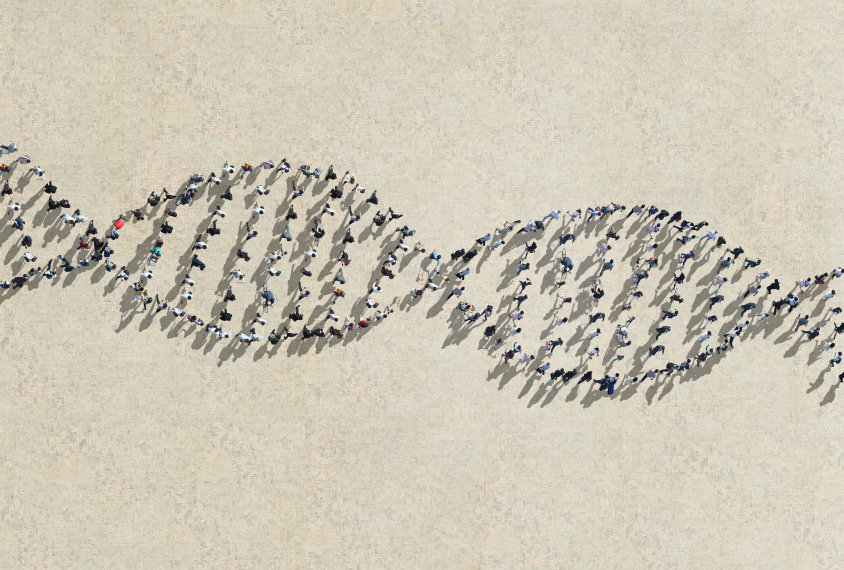
Variant analysis may vastly underestimate heritability of autism behaviors
Existing genome scans do not detect many of the DNA variants that underlie behavioral problems.
An analysis of DNA variants suggests the heritability of childhood behavior problems, including autism traits, is about 6 percent, researchers report in a new study1. When the same team looks at the heritability by analyzing twins, however, their estimate comes in at 50 percent.
The low estimate is based on a scan of genomes for known DNA variants, called single-nucleotide polymorphisms (SNPs). The researchers also looked at traits such as anxiety, depression and hyperactivity, as well as autism features, such as not being able to pick up on social cues. By comparing the variants and traits in thousands of people, researchers can identify which variants are associated with specific traits and behaviors.
For their twin analysis, by contrast, the researchers looked at the frequency of behavioral traits in identical twins — who share virtually all of their DNA — versus fraternal twins, who share only about half. Comparing the frequencies can provide an estimate of the behavior’s heritability.
The new results suggest that existing genome scans do not detect many of the variants involved, and that scientists need better measures of these traits.
“These findings don’t mean that we shouldn’t be using genetics to study childhood behavior problems,” says Elise Robinson, assistant professor of epidemiology at the Harvard T.H. Chan School of Public Health. “But they do suggest that we need to figure out a better way to measure behavioral problems in children.”
Missing interactions:
Robert Plomin’s team at King’s College London combed data from more than 4,700 twin pairs in the Twins Early Development Study at ages 12 and 16. In that project, parents, teachers and the children themselves filled out questionnaires designed to identify 37 emotional, behavioral, conduct and social problems. One measure, the Childhood Autism Spectrum Test, covers autism features.
The project also includes DNA from nearly 5,000 twins, and analysis of the DNA for common SNPs.
The 50 percent heritability they found among twins is in line with results from previous twin studies — but far higher than the 6 percent estimate from SNPs. The results appeared 12 December in Translational Psychiatry.
“The SNP-twin heritability gap we found suggests that much more research is needed to achieve these goals [of improving risk prediction] for childhood behavior problems,” says Rosa Cheesman, a graduate student in Plomin’s lab. (Plomin was unavailable for comment.)
The work bolsters the results of two other SNP studies: These studies reported a heritability of 21 percent in attention deficit hyperactivity disorder and 11 percent in autism2,3.
Assigning risk:
The SNP analyses assess millions of common gene variants, not just those known to be associated with behavior problems. However, they exclude rare variants — those that occur in less than 1 percent of the population. They are also not designed to associate behavioral problems with interactions among numerous common variants.
Twin heritability measurements take into account all of these contributions.
That means estimates of SNP heritability are always less than those from twin studies. But for most complex traits, including height, weight and intelligence, the gap is no more than a factor of two.
The results suggest that scientists have identified only a small fraction of the genetic influence on behavioral problems.
“Once all genes involved are identified, as well as their interactions and modes of action, SNP and twin heritability will hopefully be more or less the same,” says Dorret Boomsma, professor of biological psychology at Vrije University in Amsterdam, who was not involved in the study.
The findings also may reflect an inconsistency in behavioral measures, which vary from one test to the next and can’t capture the nuance of complex traits, Robinson says.
“We have to be cautious in making blanket statements about any given behavioral domain in kids, let alone all of them together, because the manner in which we measure really impacts those estimates,” she says.
Plomin and his colleagues plan to study SNP heritability in larger numbers of people to increase the odds of detecting the genetic influences on behavior.
References:
Recommended reading

Expediting clinical trials for profound autism: Q&A with Matthew State

Too much or too little brain synchrony may underlie autism subtypes
Explore more from The Transmitter

Mitochondrial ‘landscape’ shifts across human brain

